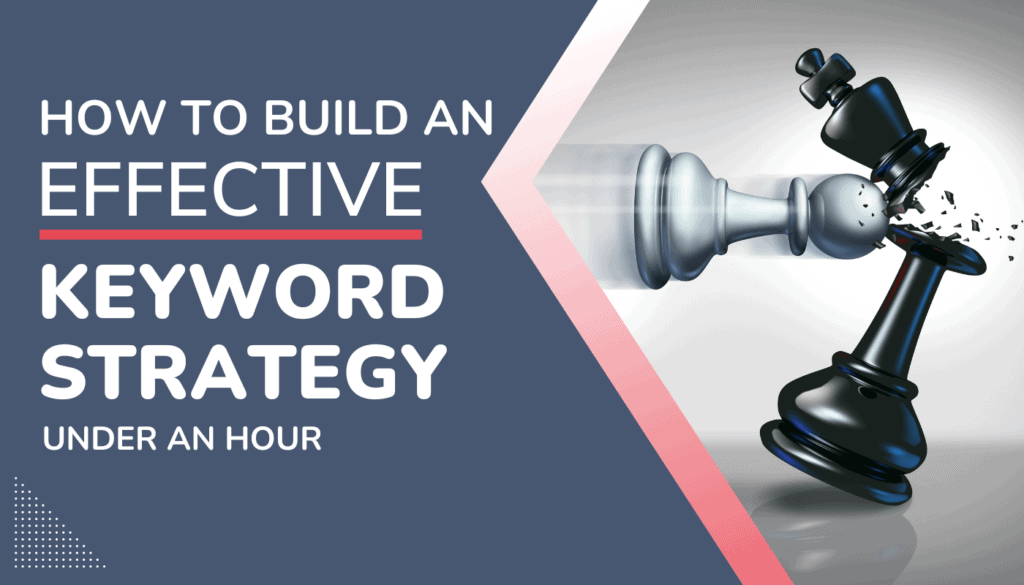If you are new to the world of SEO or if you are a Search expert and keyword targeting has no secrets to you, then you’ve come to the right place! We all want to create useful and high-value content that converts and conducts keyword research in no time. This article is about creating more effective content strategies targeting long-tail keywords using our minute-proven method. Long-tail keywords bring the highest searcher’s intent and have a higher conversion value than short-tail keywords. How to target these high-value long-tail keywords in your niche and craft an effective content strategy around these search terms to start ranking your content on Search Results?
Check out our guide on How To Start A profitable Blog to explore how to select profitable niches for your blog, write down your goals and content strategy and create the perfect SEO-friendly structure to support your keyword strategy.
Otherwise, let’s dive in!
Long-tail keyword definition
Long-tail keywords are three-four keyword phrases that are more specific than short-tail keywords. They usually have a lower search volume but convert very well compared to short-tail keywords. There are usually used to target niche audiences who have a specific interest with high search intent.
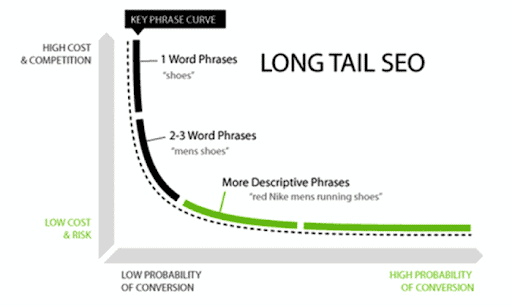
For Example: ‘Keto Diet” is a high-volume keyword whereas ‘Free Keto Diet For Beginners’ is a 5-term search phrase qualified as a long-tail keyword. The long-tail keyword clearly indicates a higher intent of the searcher to find free keto diet plans online and already qualified himself as a ‘beginner’.
Long-tail keyword vs. Short-tail Keywords
Long-tail keywords are terms that you need to include in your content strategy as they have several advantages:
Lower competition
Long-tail keywords have lower competition than short-tail keywords which means that it will be easier to rank for these terms. Lower competition does not necessarily mean lower search volume. There are long-tail keywords with higher search volume than their short-tail version.
Lower Keyword Difficulty
Keyword Difficulty is a metric used in SEO and keyword strategy to estimate how difficult it would be to rank on Google’s top 10 search results for a given keyword. Scaled 0 to 100 with 100 being the hardest to rank for. While this is not always true, in most cases, the higher the keyword intent, the lower the search volume and the lower the ranking difficulty. Most SEO and Keyword research tools such as SEMRush, Moz, and AHrefs provide this metric to plan an effective keyword strategy for your site.
Higher conversions
Long-tail keywords have a high-converting traffic value which means that if you target these terms, you are likely to drive high-intent visitors to your blog who are likely to take action.
Higher intent
Long-tail keywords are high-intent keywords. Understanding and creating content with user intent in mind is critical. If you read our article “How to Start A Profitable Blog”, we explain that your blog content strategy should focus on the pillar and auxiliary content. You need to create key content targeting high competition and high-volume keywords to build your organic traffic but you also need to focus on auxiliary content with lower search volume and competition to drive revenue and conversions.
Keywords and search intent
There are 4 types of Search Intent :
Informational
In this case, the searcher is looking for information such as:
- “What is Keto?”
- “Keto Diet”
- etc.
Navigational
Navigational intent indicates that the searcher has a more specific idea of what they are looking for. Especially when looking for a specific website. For example:
- “Weight watchers keto diet”
- etc.
Comparative Investigation
In this case, the searcher is looking to compare products and services before making a final decision to purchase. The usual long-tail keyword for this type of intent includes terms such as “vs.” and “reviews”.If you run an affiliate blog, these terms are essential to target as you offer curated content to an audience almost ready to convert. For example:
- “Keto vs. Paleo diet”
- “ Keto diet plan reviews”
- etc.
Transactional
At this search intent stage, when the user searches for these terms, they are most likely is ready to make a purchase or take action. They are at the bottom of the funnel and are looking for specific products, services, or solutions. It is usually easy to identify these long-tail keywords as they usually start with action verbs such as” buy”, “best” or” start”:
- “Start keto diet today”
- “Best keto meal plans with shopping lists”
- etc.
Now that we identified what long-tail keywords are and classified their search intent value, let’s look at how to find and target these long-tail keywords for your content strategy.
How to create your SEO Keyword Strategy?
There are several ways to find and target keywords in your niche. We created this 10-step method that we tested and that should be easily completed in under an hour. In this article, we will use Google Sheets to organize the process and the keyword research.
Note: If Google decides to award top-ranking positions for websites, it is for a reason; the content is useful for users and aligned with E.E.A.T; Experience, Expertise, Authoritativeness, and Trustworthiness. Google always updates its Quality Rater Guidelines to make the perfect match between a searcher’s term and the most relevant results associated with that query. That’s why analyzing the top 10 search results for your targeted keywords is critical in the process of building a strong keyword strategy for your blog or online business.
Step 1: Start with your seed keywords list
Assuming you start a new blog or online business, the first thing you need to do is to write down a list of seed keywords.Let’s say you are starting a blog about ketogenic diets and foods.
Your main seed keywords -or topical cluster-can be:
- Keto diet
- Ketogenic diet
- Keto food
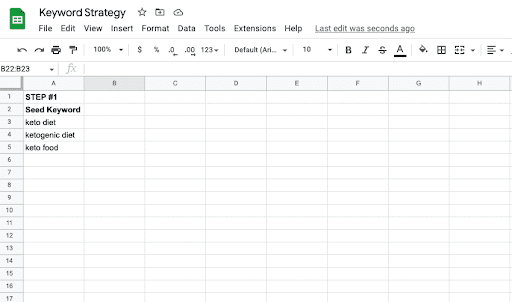
Step 2: Use Google autocomplete to find long-tail keywords
Once you have a list of seed keywords to start with, the second step is to head to Google Search and search for each of these terms to see what Google Autocomplete keywords suggestions Google is coming up with. This feature predicts the rest of the query you start searching based on a database of millions of searches.
For our seed keywords, below are the auto-complete suggestions, that are long-tail keyword versions of our seed keyword. At this step, we can start to identify that not every keyword carries the same intent or value, and can target a different subset of the audience interested in Keto.
Also, targeting longer tail keywords can also uncover many different user search intent;
- “Keto diet for beginners” searches are likely coming from users interested in starting out with this diet and are looking to narrow down information about the diet.
- “keto food delivery service” searches are bottom-of-funnel searches, high-intent with an intention to act or purchase. In that case, restaurants serving keto meals and delivery services should target these keywords.
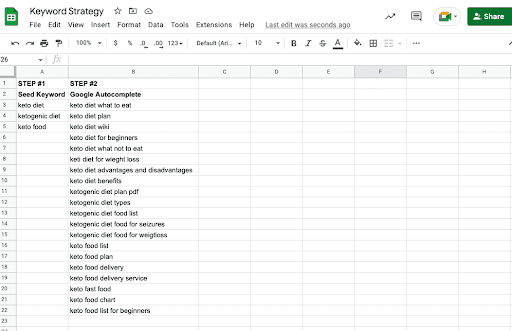
Write down these Google autosuggestions and repeat the process for each of your seed keywords. Now our list starts to become interesting with new keywords suggesting “list”, “plan”, and other intent identifiers such as “ for seizure”, “for beginners” etc.
Step 3: Look at the “People Also Ask” section of Google Search
Google Search has another very useful feature section called “People Also Ask”(PAA). This box features direct questions asked when searching for a query. Google uses its advanced algorithm to return the most relevant answers to these questions.
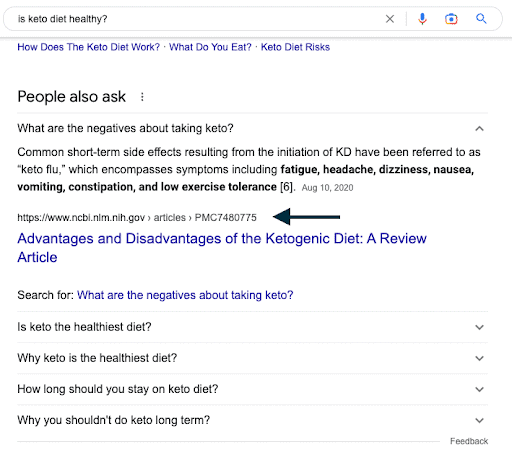
For example for a question such as “Is keto diet healthy?”, Google found ncbi.nlm.nih.gov to provide the most relevant answer. Google then “rewards” the site by giving the site a featured snippet in the PAA section of the SERPs. The “People also ask” section is extremely useful if you plan to write a FAQ or create content using informational and long-tail key phrases.
In that example, while half of the results indicate that Keto diets may not be the best diet plan due to its known side effects and symptoms, educating your audience on that aspect through product reviews and alternative recommendations for a subset of your audience unfit for this diet model, can be part of an effective content and targeting strategy for your blog.
Continuing on our Keto diet example, for each of your seed keywords, write down the key phrases that appear in this section.
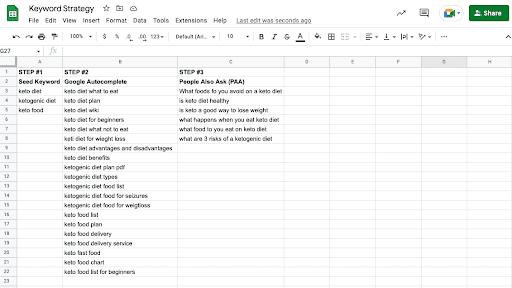
Step 4: Look for Google Related Searches and Suggestions
The last useful feature Google Search offers to help you find long-tail keyword ideas for your content strategy is the section “ GoogleRelated Searches”, this section usually appears at the bottom of the SERPs.
For the search “ keto diet” and for “keto food”, below is the suggested related terms Google displays. For most cases, results in the related searches will be similar to results from auto-suggest, with additional terms.
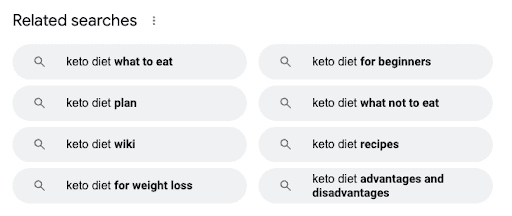
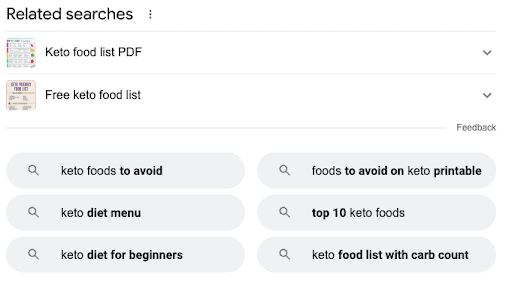
Steps 1 to 3 can be repeated for as many seed keywords as you list. For example, adding “keto diet travel” or keto diet brands” to the list. Additional interesting keyword long-tail keywords will continue to build à solid keyword strategy to target different audience subsets and sub-niches.
Continue to add long-tail keywords to your list. At this point, you will notice keywords and terms that can be great to target for content. For example, “keto diet on road trips” or “keto travel hacks” are great keyword ideas to focus on. We all know that following a diet while traveling is not easy. You can target healthy travelers by writing” travel guide hacks for keto dieters”.
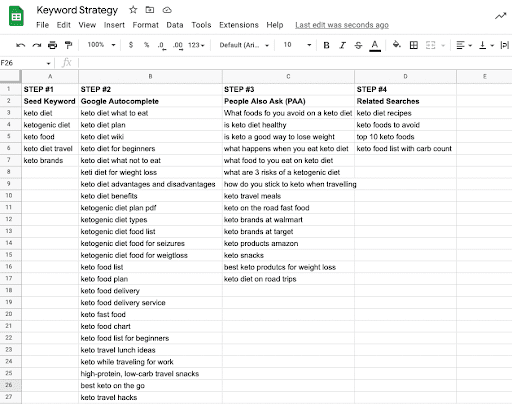
Step 5: Discover new Keywords with Google Keyword Planner Tool
Google Keyword Planner Tool is another way to organize your keyword strategy and get new ideas for keywords and /or see the performance forecast for a specific set of keywords if you invest in paid search campaigns. In this example, we won’t run any PPC campaigns and utilize the tool to better organize your keyword research.
First, if you don’t have an account yet, you can access the keyword planner tool, by following these 4 steps: :
- Sign in to Google Ads > add new Google Ads account
- Click on “switch to Expert Mode” on the next screen
- Next screen, click on “create an account without a campaign”
- Hit “Submit” on the next screen and then “Explore your account”
Once you created your Google Ads account (without having to create an ad campaign), head to “tools and settings” to get to the ‘Planning’ menu where you will find the Keyword Planner tool.
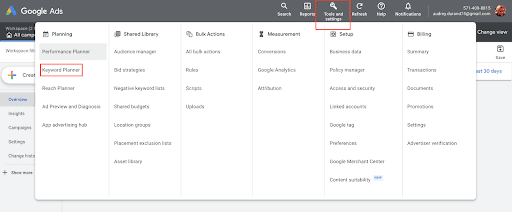
Using our keto diet example, we can research new keyword ideas and topic clusters to use for our content strategy and that google ads users target when running PPC.
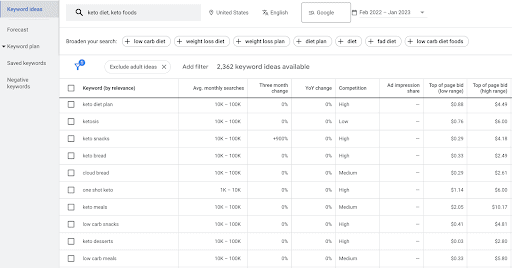
If a keyword has no CPC, this is an indicator that there is no real demand for it. You should identify keywords with CPC and impressions and clicks.
Let’s continue to expand our google sheet adding ideas from Google Keyword Planner tool
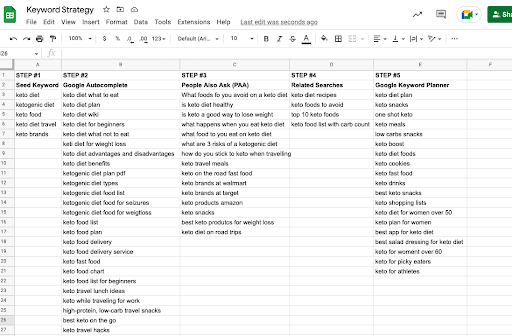
Step 6: Review Google trend
Another great feature from Google that can help you with your keyword research is Google Trend. By looking at the trend of your keywords, you can analyze and understand the popularity of the searches over time and for specific geographic areas.
Google Trend also displays related queries that you can use to complete your keyword master list. You can visualize the top 25 rising queries that could be potential keywords to target a piece of content around.
Let’s add relevant resign queries around Keto Diet to our master list. You can easily download a CSV list directly from Google Trend and add the queries to your list.

While the past 12 months indicate an overall downward trend for “keto diet”, there are a few rising topics and terms that are worth exploring further such as ”keto gummies”, :keto diet gummies”.
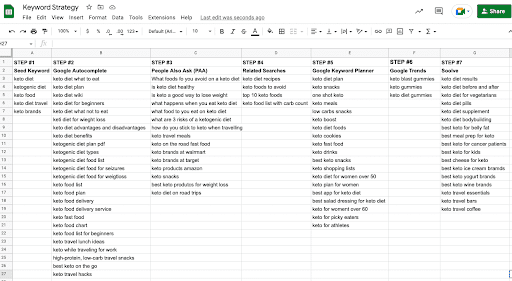
Step 7: Identify additional long-tail Keyword Ideas with Soolve
We covered a lot so far! From a handful of seed keywords, Google features helped us build a seed list of 70+ topical keyword clusters and long-tail variations to use for our site content strategy. But the goal is not to come up with thousands of keywords and not to know what to do with them. Once we build our master list, we will narrow it down to a smaller but actionable keyword list.
Soolve is a free, easy-to-use, and convenient search suggestion tool that will help you find additional keyword suggestions “outside” of Google. Soolve is looking for suggestions from the most popular internet providers and search engines such as Wikipedia, Yahoo, Youtube, and Bing.
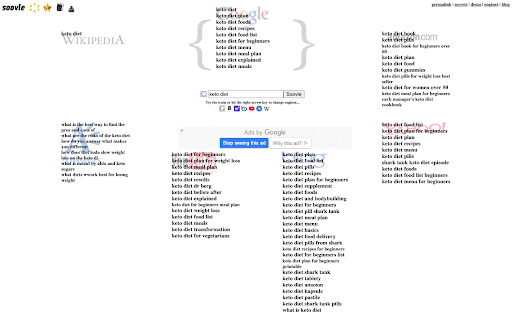
By looking for suggested terms around “keto diet”, the keyword tools return new terms that we can add to our master list such as “ keto diet for vegetarians”, “keto diet pills” etc.
Continue to search for your seed keyword but also for other long-tail keyword suggestions for terms around keto and travel. Don’t forget to add them to your master list.
Step 8: Quora and Reddit Forum
Quora and Reddit are two excellent sources of content and keyword ideas that can come supplement your list. Why? Because you usually get answers on the topic of interest from your audience. You get to see what terms of jargon they use to discuss the topic.
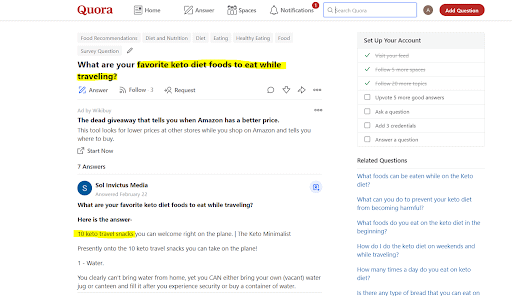
Look at the comments and answers, there are full of additional keywords and content ideas to add to your master list.
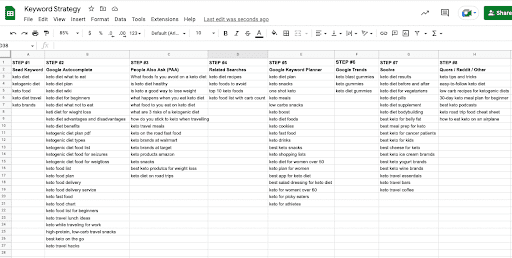
Step 9: Look for Related Queries with SEMRush
Finally, you can complete your master list by using the keyword tool of SEMRush. Looking for variation of the keyword “ ket diet”, SEMRush suggests 167K+ keyword variations and questions you can explore to expand your master list. Note that for a niche such as keto food and diet, variation keywords can score high keyword difficulty.
By looking at the long-tail version, you can pinpoint options with high-intent search and with lower keyword difficulty.
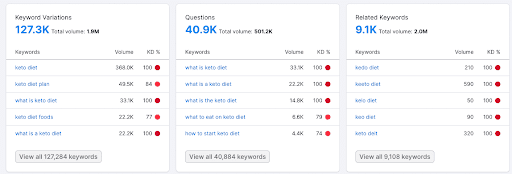
For example, by filtering keywords with difficulty below 50 and with the modifier “ best”, below are additional long-tail keyword ideas to explore
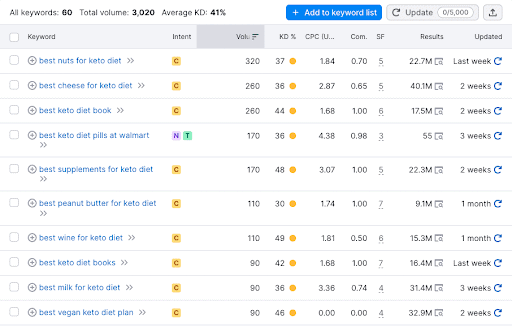
Still using SEMrush we can now look for data such as monthly search volume to identify a curated list of long-tail keywords to target.
SEMRush is the perfect all-in-one solution that provides valuable insight for your keyword research. You just need to enter your seed keywords and get access to millions of related search queries. By filtering the results, you can create your own keyword lists and export batches of valuable keyword terms to start building your content strategy.
Try SEMRush Keyword Magic for FREE

Once you get keyword data from SEMRush and add more keywords to your master list, you are ready to finalize our method by using additional AI tools to identify additional keyword variations or LSIs.
Step 10: Consult AI tools for LSI Keywords
Latent Semantic Indexing (LSI) Keywords are phrases of terms Google sees – and classifies – as to be semantically related to a topic. If you are looking for keto diets LSI keywords, below is an example of using AI tools such as ChatGPT or aiseooutlines.com to generate additional keyword variation ideas
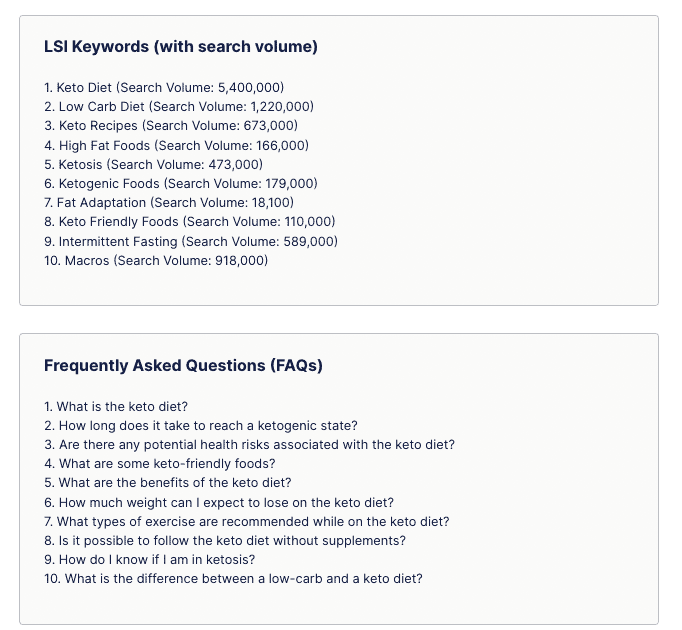
And below, ChatGPT prompt and outcome for LSI Keyword ideas for “keto diet”, “keto foods”, “keto while traveling, and “keto meal plans for seniors”. You can continue to finetune your prompt to get more ideas and variations from the tool.
| Keto Diets | Keto Foods and Snacks | Keto while traveling | Keto Meal Plans for Seniors |
|---|---|---|---|
| Low Carb Diet High Fat Diet Low Carb High Protein (LCHP) Diet Fat Adaptation Ketosis Carb Cycling Intermittent Fasting Fatty Acids Glycemic Index Insulin Resistance Metabolic Syndrome Weight Loss | Coconut Oil Grass-fed Butter Fatty Fish Grass-fed Beef Cage-free Eggs Cheese and Dairy Dark Chocolate Almond Flour Hard-boiled Eggs Cheese Cubes Nuts and Seeds Mix Pork Rinds Avocado Slices | Pre-packaged Low Carb Snacks Nuts and Seeds Mix Beef Jerky Hard-boiled Eggs Low Carb Protein Bars Pre-cut Vegetables Fast Food Options (Burgers without buns, Grilled Chicken Salads, etc.) Coffee with Heavy Cream Cheese Sticks Canned Tuna or Salmon | High Protein Meals Low Carb Vegetables Fatty Fish Grass-fed Beef Cage-free Eggs Low Carb Soups Avocado Slices Coconut Oil or Olive Oil for Cooking Low Carb Snacks Low Carb Desserts |
There you go! We have finalized our 10-step method to build your keyword strategy around the topic of keto diet and keto food.
The final step before moving to craft your content strategy around these keywords is to format your master list and map additional SEO metrics and stats:
- Copy the seek keyword tab into à new tab. Let’s call it “keyword data”
- Consolidate all columns of keywords into one single column
- Sort Sheet A to Z
- Select Data > data cleanup > remove duplicates
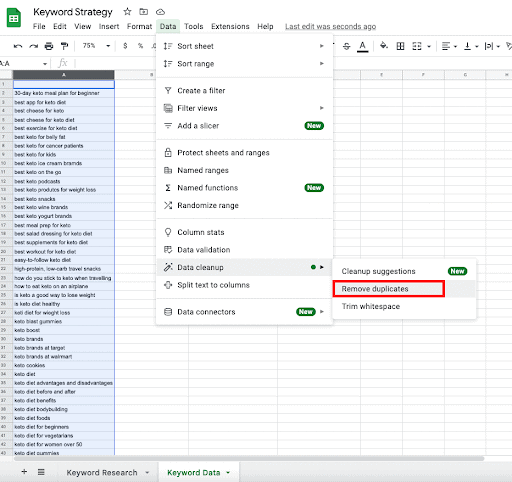
Et voila! Using SEMRush, Google Keyword Planner or any other keyword performance tool, you can now review stats and metrics and identify the final keyword list to work with your content strategy.
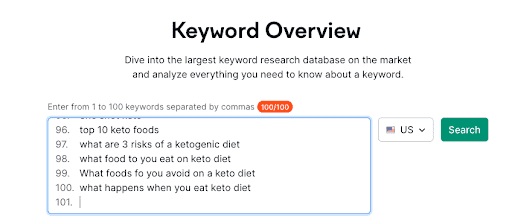
Export data in a CSV or Excel format and copy the list over to your existing Google Sheet , under the “keyword Data” list.
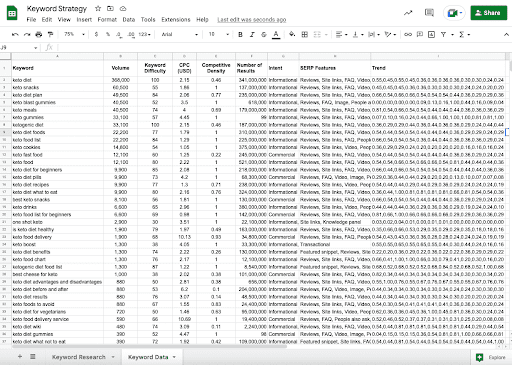
Now that you have your list ready, it is time to put your content strategy in place.
Create a Long-tail keyword content strategy
Once you finalize our 10-step method to build your SEO keyword strategy, it is time to prepare your content plan ideation. We strongly recommend focusing your efforts on these 2 content structures: :
1- Create long-form pillar content
The first content strategy to plan for is to create long-form pillar content that targets your high competition/high search volume keywords in order to build organic traffic to your site. From our keyword strategy around Keto Diet, below are the top 15 high-competition/high search volume keywords to focus on for your pillar content and topic clusters:
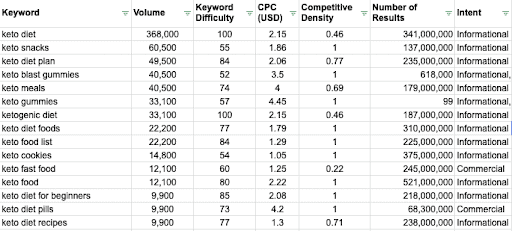
You will notice that for the most part, these keywords have informational intent, which means that users may not take immediate action such as converting, or purchasing from your site if you rank for these keywords. These visitors are still high in the funnel and are looking to gather more information.
To get these pieces of content to rank high on search engine results, think of linkbait content topics as content that can attract a larger volume of backlinks such as guides, data, research articles, etc.
Quality backlinks aka ‘inbound links’ or ‘incoming links’, are links from your website on other websites. Google’s major ranking signals are quality backlinks coming from trustworthy and authoritative sources back to your site. So think of it as votes that will help you rank higher on search engine result pages and boost your organic search traffic. You will need to create pillar content to attract more links and get to rank.
Example of pillar content to rank for your high search volume keywords: :
- “99 Delicious and Easy Keto Snacks to Satisfy Your Hunger Cravings”
- “Keto Blast Gummies: Do They Really Work? A Comprehensive Review”
- “30 Mouthwatering Keto Meals You Can Make in Under 30 Minutes”
- “Keto Cookies: Indulge in Your Sweet Tooth Without Breaking Your Diet”
- “The Science Behind the Keto Diet: How It Works and Why It’s Effective”
- “How to Stay on Track with Your Keto Diet While Traveling“
- “22 High-Protein Keto Foods That Will Help You Stay in Ketosis”
- “Keto Meal Prep 101: Tips and Tricks for Planning and Preparing Your Meals”
As this pillar content is evergreen, you can add more content and section over time. These are essential keywords to target even if very hard to rank for. That’s why you need to couple your content structure and plan around building auxiliary content to boost your main keyword to rank and earn authority.
2- Create auxiliary content
Along with your pillar content, most of your content plan should be focused on creating auxiliary content around long-tail keywords with medium competition and search volume to drive user engagement and conversions. The goal is to build authoritativeness by creating content around long-tail keywords that are part of a larger topic cluster, targeted in your landing pages and blog posts.
Auxiliary content not only boosts the relevancy and expertise of your main content pillars but is “monetizable” content you can implement to generate revenue and passive income for your blog later on.
For example, to support ranking pillar content targeting keto diet keyword, you can plan to focus on keto diet for vegetarians and write 3-4 blogs to “blanket” the sub-topic such as :
- “Keto-Friendly Vegetarian Snacks for When You’re on the Go”
- “How to Incorporate Healthy Fats into Your Vegetarian Keto Diet“
- “How to Get Enough Protein on a Vegetarian Keto Diet“
- “The Best Low-Carb Vegetarian Sources of Fiber for a Healthy Digestive System”
- “Vegetarian Keto on a Budget: How to Save Money While Eating Healthy”.
Hyper-targeted pieces of content around easy-to-rank keywords will not only drive high-intent traffic to your site but help your pillar content rank for a higher funnel more competitive parent topics.
Remember to focus first on creating content that ranks and drives more traffic to your site before thinking of monetizing its traffic from day 1.
Wrapping-Up
Keyword strategy does not have to take hours. With the right strategy and approach you can create a robust SEO strategy and plan in under an hour by doing research on Google or by using tools such as Soolve or SEMRush. Analyzing users’ intent and targeting long-tail keywords and LSI phrases will help your site generate traffic and better engage with your audience. Make every session and page view count.
Keyword intent can be informational or navigational. It can also be users investigating and comparing products prior to making a purchase. Some of these long-tail keywords can also have a transactional intent and are highly recognizable when users search for keywords using terms such as “best”, “get” etc.
Once you get to a list of converting long-tail keywords you can prepare long-form pillar content to build your traffic and hyper-targeted pieces of content you can monetize later on.
While you can use our method with 99% of free tools, you can start using SEMRush Keyword Magic Tool for FREE for all your keyword and content strategies and upgrade to a premium plan at any time.
Don’t hesitate to drop a comment on your SEO keyword strategy and plan using our one-hour research method if you find it useful.
Happy Keyword Research!


